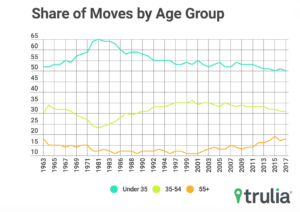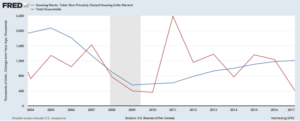
Image: dailymail.co.uk
More millennials are living with their parents than ever before due to lack of income, availability of housing and marriage later in life. Moves by people under age 35 are continuing to decline. Seniors are moving a bit more but overall they are staying put in their homes for retirement, as the cost to move to a new home is soaring. Home prices have increased on average by 6.7 % per year over the past five years, skewed toward large square foot homes for upper income buyers.

Source: Trulia – 1/31/2018
Overall Americans are not moving like they used to in the 1990s, and before the Great Recession. In 2017, 34.9 million Americans moved to new residences, translating to a household mobility rate of 10.9%, which is the lowest rate in the last 50 years since the Census Bureau has been tracking this statistic. Lack of mobility is showing up in total household formations including rental units, new and existing home figures. For all of 2017 there were only 400,000 household units formed, notice this is a similar pace to the aftermath of the Great Recession.

Source: Federal Reserve of St. Louis, 1/2018
The mobility that is taking place is from major cities to major cities or coast to coast. We noted in our post on Heartland Economics that one of the issues that faces many rural regions in the South and Midwest is lack of new jobs, digital infrastructure, health and education services. When young people in these regions cannot receive the education they need to build a career where there are jobs in the cities they stay where they are in low wage jobs with few prospects of advancement. The opioid epidemic is worst in rural regions in the country where a sense of hopelessness has set in for many people. While in the last quarter some of these regions have seen an increase in jobs, this increase in economic activity is likely to be a passing surge from a very low economic base to begin with that will not last without long term investment.
Next Steps:
Why should we be concerned with lack of workforce mobility? Because, when people do not move to take on new jobs, or start families or get away from home, home purchases decline, furniture sales drop, appliance sales fall and the overall economic life blood of our economy stagnates. What do we need to do? Raise wages for workers to a decent level in each metro and rural region of the country, so people can build a nest egg and make a down payment on a home. Rental unit pricing needs to be addressed in a way that is fair to the multiunit owner while holding down rental costs. The most recent Tax Bill passed in December of 2017 eliminated the provision for tax deductions by employers or workers for unreimbursed moving expenses. This provision needs to be reinstated to drive the costs of moving down. Interest on first mortgages should be made tax deductible for all regions of the country with a special emphasis on low income first time buyers. In rural regions we recommend special tax zones be established to offer incentives for investors to setup businesses there, with partnerships with local universities to build incubators for startups much along the model pioneered in Silicon Valley yet tuned to the needs of the region. The size of our workforce is declining, we have young people staying at home so we need to address the issue of lack of mobility head on to provide the life opportunities to our young people that earlier generations enjoyed.
